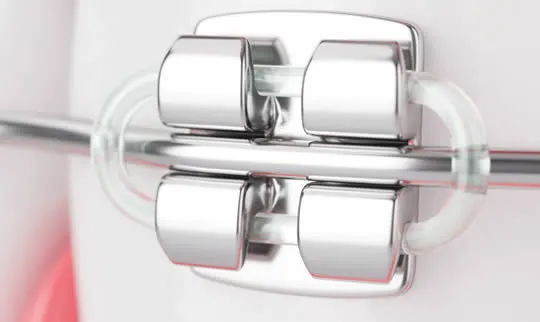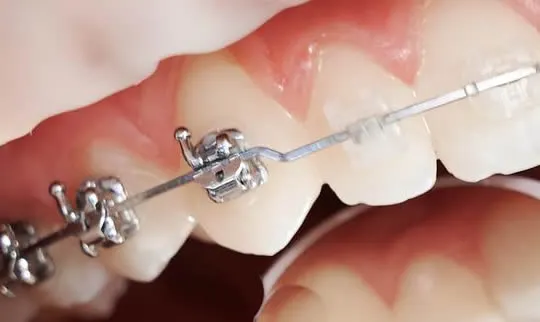Braces are commonly used by orthodontists to enhance smiles and address dental concerns. They improve appearance, alleviate eating and speaking difficulties, and tackle oral health issues such as uneven tooth wear, jaw pain, and cavities. Braces also restore confidence in patients with low self-esteem. At practiceName in Baltimore, drName expertly utilizes braces to correct smiles and boost self-assurance. How do braces achieve these transformations?

Brackets: The Foundation of Orthodontic Treatment
Dental brackets, the cornerstone of orthodontic treatment, are small, square-shaped devices typically made of metal or ceramic. These brackets play a crucial role in attaching the archwire to the teeth, facilitating the movement necessary for correcting misalignments. Metal brackets are the most commonly used due to their exceptional durability. On the other hand, ceramic brackets offer a tooth-colored appearance that is less noticeable, making them a preferred choice for individuals seeking a more discreet treatment option. To secure the brackets to the teeth, a dental adhesive is applied and then cured using a special light. Generally, the brackets are positioned at the center of each tooth, and the archwire is threaded through them, exerting pressure on the teeth to guide them into proper alignment. Depending on the specific requirements of the patient and the type of orthodontic treatment, brackets can be either self-ligating or require elastic ties to hold the wire in place. In terms of placement, brackets can be designed for either the front or back of the teeth. Traditional braces typically feature brackets affixed to the front of the teeth, while lingual braces have brackets positioned on the back, ensuring a more inconspicuous appearance.
Wires: The Movers and Shapers
Archwires, another fundamental component of braces, are thin, flexible wires that are connected to the dental brackets. These wires apply gentle and gradual pressure to the teeth, guiding them into the desired positions. While stainless steel is the most commonly used material for archwires, other options such as nickel-titanium or beta-titanium may also be employed. The wires are secured to the brackets using small elastic o-rings or self-ligating brackets. To add a touch of personalization to the treatment, patients can choose from various colors for their o-rings, allowing their smile to reflect their unique personality. Archwires are available in different sizes and materials to accommodate the specific tooth movements required. Throughout the course of treatment, drName periodically replaces the wires, starting with thinner sizes and progressing to thicker ones, ensuring a customized approach tailored to each patient’s needs.


Metal Bands: Anchoring Stability
Metal bands, also known as orthodontic bands, serve as thin, metal rings that anchor dental appliances like braces, headgear, and expanders. These bands are typically made of stainless steel or titanium and are placed around the molars, providing a sturdy foundation for the orthodontic appliance. Dental cement is used to secure the bands in place, and a bracket is attached to the band to hold the archwire. Although metal bands are less commonly used today, as most orthodontic appliances directly attach brackets to the teeth, they may still be employed in specific cases where additional anchorage is necessary or when a patient has a dental restoration on a molar.
Tooth Movement: The Journey to a New Smile
Once drName places the brackets, wires, and bands, the transformative journey toward a new smile begins. This process is gradual, relying on the application of pressure from the archwire on the brackets to guide the teeth into their correct positions. In some cases, additional tools such as rubber bands or springs may be utilized to facilitate specific movements, such as shifting teeth from side to side. Notably, the archwire not only influences the teeth themselves but also exerts pressure on the surrounding tissues, known as periodontal ligaments, which results in the gradual loosening of teeth within their sockets.
As the archwire continues to guide the teeth, they effectively move into their designated places. Throughout this process, the wire plays a vital role in maintaining the teeth’s new positions while allowing the supporting tissues to regenerate. It is crucial to note that the stabilization of teeth in their corrected alignment can take up to a year. To ensure optimal progress, drName schedules regular follow-up appointments during the period when the braces remain on the patient. This enables continuous monitoring of the treatment’s effectiveness and allows for any necessary adjustments to be made.
Once the teeth have fully stabilized in their new positions, drName will remove the braces, unveiling a remarkable transformation and a brand new smile. The patient can enjoy the results of their orthodontic journey, with improved dental alignment, enhanced oral health, and a newfound sense of self-confidence.

Braces Transform Smiles
Braces serve as a remarkable tool used by orthodontists like drName at practiceName in Baltimore to address various dental concerns and enhance smiles. By combining brackets, wires, and bands, braces exert gradual pressure on the teeth, guiding them into proper alignment over time. The process involves regular adjustments, as well as the use of additional tools when necessary, to achieve optimal results. With the expertise and guidance of drName, patients can embark on a transformative journey toward a beautiful, healthy smile and increased self-confidence.
ADDITIONAL FREQUENTLY ASKED QUESTIONS ABOUT HOW DO BRACES WORK
Are braces only used for improving the appearance of crooked teeth?
No, braces serve a broader purpose than just enhancing appearance. They can also address difficulties related to eating and speaking that arise from tooth misalignment. Furthermore, braces effectively tackle oral health issues like uneven tooth wear, jaw pain, and cavities resulting from challenges in cleaning gapped or crowded teeth.
How long does it take for braces to stabilize teeth in their new positions?
The process of stabilizing teeth in their corrected alignment can take up to a year. During this time, regular follow-up appointments are scheduled to monitor the progress of the treatment and make any necessary adjustments.
Can braces be discreetly worn?
Yes, there are options for more discreet braces. Lingual braces, for example, have brackets placed on the back of the teeth, providing a less noticeable appearance. Ceramic brackets, which are tooth-colored, are also available for a more inconspicuous look.
Are there different materials used for archwires in braces?
Yes, archwires are typically made of stainless steel, but other materials like nickel-titanium or beta-titanium can also be used. The choice of material depends on the specific tooth movements required and the preferences of the patient.
What are the functions of rubber bands in orthodontic treatment?
Rubber bands are sometimes used in conjunction with braces to direct specific tooth movements. They can be used to guide teeth from side to side or to correct other specific alignment issues.
Can braces be used for patients with dental restorations?
In certain cases where additional anchorage is needed or when a patient has a dental restoration on a molar, metal bands may be used instead of attaching brackets directly to the teeth. These bands are placed around the molars and provide a stable anchor for the orthodontic appliance.
Will wearing braces improve self-confidence?
Yes, braces can have a positive impact on self-confidence. Patients who feel embarrassed about their smiles often experience low self-esteem. By addressing dental concerns and achieving a beautiful, aligned smile, braces can significantly improve a patient’s self-assurance and overall well-being.
Helpful Related Links
- American Dental Association (ADA). Glossary of Dental Terms.
- WebMD. Children and Orthodontics.
